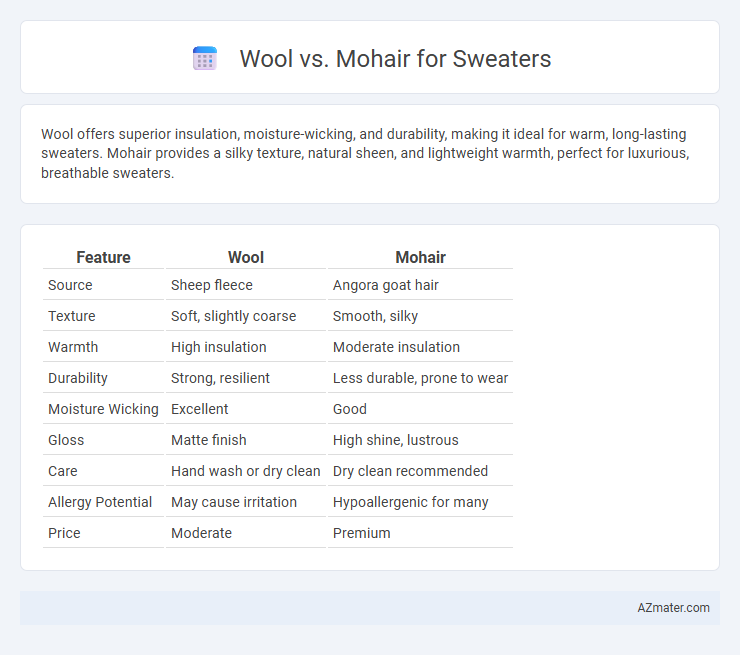Wool offers superior insulation, moisture-wicking, and durability, making it ideal for warm, long-lasting sweaters. Mohair provides a silky texture, natural sheen, and lightweight warmth, perfect for luxurious, breathable sweaters.
Table of Comparison
| Feature | Wool | Mohair |
|---|---|---|
| Source | Sheep fleece | Angora goat hair |
| Texture | Soft, slightly coarse | Smooth, silky |
| Warmth | High insulation | Moderate insulation |
| Durability | Strong, resilient | Less durable, prone to wear |
| Moisture Wicking | Excellent | Good |
| Gloss | Matte finish | High shine, lustrous |
| Care | Hand wash or dry clean | Dry clean recommended |
| Allergy Potential | May cause irritation | Hypoallergenic for many |
| Price | Moderate | Premium |
Introduction: Wool vs Mohair Sweaters
Wool and mohair are two popular fibers used in sweaters, each offering unique qualities in warmth, texture, and durability. Wool, derived from sheep, is known for its excellent insulation, moisture-wicking ability, and versatility in various sweater styles. Mohair, sourced from the Angora goat, provides a silky sheen, lightweight softness, and exceptional luster that enhances sweater aesthetics.
Origin and Production of Wool and Mohair
Wool originates primarily from sheep breeds such as Merino, known for fine, soft fibers harvested through shearing. Mohair is derived from the Angora goat, with fibers collected by shearing or combing, valued for its smooth, silky texture. Wool production is concentrated in countries like Australia and New Zealand, while mohair is predominantly produced in South Africa and the United States, influencing availability and cost.
Texture and Softness Comparison
Wool offers a dense and slightly coarse texture that provides substantial warmth, while mohair is renowned for its silky, smooth fibers that create a lightweight and luxuriously soft feel. Mohair's finer strands result in a more lustrous sheen and less itchiness compared to the somewhat rougher texture of traditional wool. Sweaters made from mohair typically deliver superior softness and a glossy finish, making them ideal for sensitive skin and elegant garments.
Warmth and Insulation Properties
Wool provides excellent warmth and insulation due to its natural crimp, which traps air and retains body heat effectively, making it ideal for cold weather sweaters. Mohair, sourced from the Angora goat, offers superior insulation with a silky texture that enhances moisture-wicking and breathability, while maintaining warmth even when damp. Both fibers excel in thermal regulation, but mohair's lightweight insulation is preferred for luxurious, less bulky sweaters compared to the thicker warmth of traditional wool.
Durability and Longevity Factors
Wool fibers are known for their elasticity and natural crimp, enhancing sweater durability by resisting wear and maintaining shape over time. Mohair, derived from the Angora goat, offers exceptional strength and a silky texture that resists pilling and holds vibrant colors, contributing to longer-lasting garments. Both fibers provide excellent longevity, but mohair's smooth surface and higher tensile strength give it an edge in durability for sweaters subjected to frequent use.
Moisture Wicking and Breathability
Wool excels in moisture-wicking due to its natural lanolin content, which repels water and helps keep the skin dry during wear. Mohair, derived from the Angora goat, offers superior breathability with its smooth, hollow fibers that facilitate air circulation, preventing overheating. Both fibers regulate temperature effectively, but wool tends to manage moisture better while mohair provides enhanced ventilation.
Allergen Potential and Skin Sensitivity
Wool sweaters, often made from sheep's fleece, contain lanolin, which can trigger allergic reactions and skin irritation in sensitive individuals. Mohair, sourced from the Angora goat, has smoother fibers and lower lanolin content, making it generally less itchy and more suitable for those with sensitive skin or wool allergies. Both fibers offer warmth and durability, but mohair's hypoallergenic properties often make it a preferred choice for allergy-prone wearers.
Care and Maintenance Differences
Wool sweaters require gentle handwashing or dry cleaning to maintain their shape and avoid shrinkage, while mohair sweaters need even more delicate care, often involving cold water handwashing and air drying to preserve their soft texture and prevent felting. Wool fibers are naturally durable, but frequent agitation can cause pilling, whereas mohair's fine, silky fibers are prone to stretching and matting if not handled carefully. Storing both types in breathable garment bags with cedar blocks helps repel moths and maintain fiber quality over time.
Cost and Value Analysis
Wool sweaters generally offer a more affordable price point compared to mohair, making them a cost-effective choice for everyday wear. Mohair, derived from the Angora goat, commands higher prices due to its luxurious softness, sheen, and durability, which enhance its long-term value despite the initial investment. When considering cost versus value, mohair sweaters provide superior insulation and elasticity, justifying their premium price for those seeking performance and luxury.
Choosing the Best Option for Your Needs
Wool offers superior insulation and moisture-wicking properties, making it ideal for cold and damp environments, while mohair provides exceptional softness and a lightweight feel suited for mild climates. Consider wool if durability and warmth are priorities, as it resists wear and retains heat effectively. Mohair suits those seeking luxury and breathability, with its smooth texture enhancing comfort without sacrificing style.

Infographic: Wool vs Mohair for Sweater
 azmater.com
azmater.com